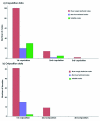Reproductive tactics of sexes and fitness in the dragonfly, Diastatops obscura
- PMID: 20302544
- PMCID: PMC2999426
- DOI: 10.1673/031.007.2401
Reproductive tactics of sexes and fitness in the dragonfly, Diastatops obscura
Abstract
The sexual selection strategies of territorial Odonata that do not present courtship behavior is still not completely understood, especially the role of the females. Diastatops obscura Fabricius (Odonata: Libellulidae) females participate in mate selection in a passive manner, allowing copulation with the first male that captures them and afterwards choosing whether to oviposit or not. This study introduces the idea of female passive choice as an adaptative tactic in intersexual selection. Also discussed is the adaptative value of this tactic and its flexibility according to environmental conditions and reproductive strategies adopted by the males. A natural population of Diastatops obscura was observed in the Pitimbu River of northeast Brazil. Focal continuous and ad libitum techniques were used to record attempted copulation, copulation, and oviposition behavior, in addition to registering male territoriality. An estimate of individual reproductive success (IRS) was obtained by recording 187 reproductive events. Territorial males, mainly occupying areas near the river margin, achieved greater copulation and oviposition success (IRS = 0.371) than did satellite males (IRS = 0.028). Females that copulated with territorial males experienced, for the most part, only one copulation and oviposition event, while those that copulated with satellite males fled or performed a second copulation with a territorial male. Thus, the best tactic adopted by the D. obscura males was to occupy a territory providing the greatest access to females, while the females used passive choice for fitness optimization.
Figures





Similar articles
-
Male coercion and convenience polyandry in a calopterygid damselfly.J Insect Sci. 2002;2:14. doi: 10.1093/jis/2.1.14. Epub 2002 Aug 7. J Insect Sci. 2002. PMID: 15455048 Free PMC article.
-
No size or density effect on alternative mate-locating tactics in the tropical damselfly Hetaerina rosea males (Odonata: Calopterygidae).Rev Biol Trop. 2009 Mar-Jun;57(1-2):361-70. doi: 10.15517/rbt.v57i1-2.11327. Rev Biol Trop. 2009. PMID: 19637713
-
An integrative view of sexual selection in Tribolium flour beetles.Biol Rev Camb Philos Soc. 2008 May;83(2):151-71. doi: 10.1111/j.1469-185X.2008.00037.x. Biol Rev Camb Philos Soc. 2008. PMID: 18429767 Review.
-
Challenging monogamy in a spider with nontraditional sexual behavior.Sci Rep. 2022 Apr 8;12(1):5948. doi: 10.1038/s41598-022-09777-7. Sci Rep. 2022. PMID: 35396561 Free PMC article.
-
Evolution of Reproductive Behavior.Genetics. 2020 Jan;214(1):49-73. doi: 10.1534/genetics.119.302263. Genetics. 2020. PMID: 31907301 Free PMC article. Review.
Cited by
-
Alternative reproductive strategies in black-winged territorial males of Paraphlebia zoe (Odonata, Thaumatoneuridae).PeerJ. 2019 Feb 20;7:e6489. doi: 10.7717/peerj.6489. eCollection 2019. PeerJ. 2019. PMID: 30809457 Free PMC article.
-
A review of chemosensation and related behavior in aquatic insects.J Insect Sci. 2011;11:62. doi: 10.1673/031.011.6201. J Insect Sci. 2011. PMID: 21864156 Free PMC article. Review.
References
-
- Blanckenhorn WU, Mühlhäuser C, Morf C, Reusch T, Reuter M. Female choice, female reluctance to mate and sexual selection on body size in the dung fly Sepsis cynipsea. Ethology. 2000;106:577–593.
-
- Cartar R. Morphological senescence and longevity: an experiment relating wing wear and life span in foraging wild bumble bees. Journal of Animal Ecology. 1992;61:225–231.
-
- Convey P. Influences on the choice between territorial and satellite behaviour in male Libellula quadrimaculata Linn. (Odonata: Libellulidae). . Behaviour. 1989;109:125–141.
-
- Corbert PS. Dragonflies: Behaviour and Ecology of Odonata. Harley Books; 1999.
-
- Córdoba-Aguilar A, Uhía E, Cordero Rivera A. Sperm competition in Odonata (Insecta): the evolution of female sperm storage and rival sperm displacement. Journal of Zoology. 2003;261:381–398.
Publication types
MeSH terms
LinkOut - more resources
Full Text Sources

